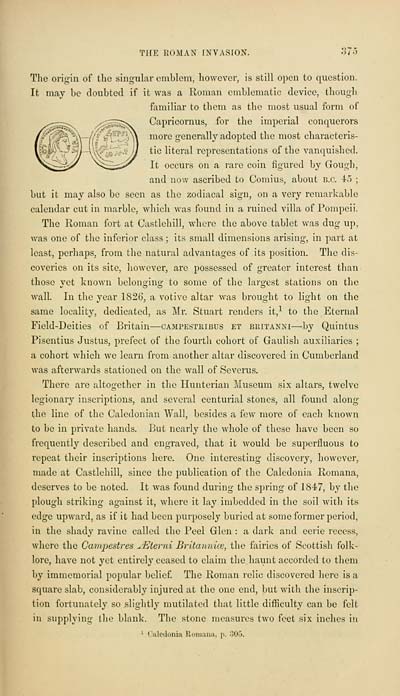Download files
Complete book:
Individual page:
Thumbnail gallery: Grid view | List view

THE ROMAN INVASION.
n75
The origin of the singular emblem, however, is still open to question.
It may be doubted if it was a Roman emblematic device, though
familiar to them as the most usual form of
Capricornus, for the imperial conquerors
more generally adopted the most characteris-
tic literal representations of the vanquished.
It occurs on a rare coin figured by Gough,
and now ascribed to Comius, about b.c. -io ;
but it may also be seen as the zodiacal sign, on a very remarkable
calendar cut in marble, which was found in a ruined villa of Pompeii.
The Roman fort at Castlehill, where the above tablet was dug up,
was one of the inferior class ; its small dimensions arising, in jmrt at
least, perhaps, from the natural advantages of its position. The dis-
coveries on its site, liowever, are jjossessed of greater interest than
those yet known belonging to some of the largest stations on the
wall. In the year 1826, a votive altar was brought to light on the
same locality, dedicated, as Mr. Stuart renders it,^ to the Eternal
Field-Deities of Britain — campestribus et britanni — by Quintus
Pisentius Justus, prefect of the fourth cohort of Gaulish auxiliaries ;
a cohort which we learn from another altar discovered in Cumberland
was afterwards stationed on the wall of Severus.
There are altogether in the Hunterian Museum six altars, twelve
legionary inscriptions, and several centurial stones, all found along
the line of the Caledonian Wall, besides a few more of each known
to be in private hands. But nearly the whole of these have been so
frequently described and engraved, that it would be superfluous to
repeat their inscrij^tions here. One interesting discovery, however,
made at Castlehill, since the publication of the Caledonia Romana,
deserves to be noted. It was found during the spring of 1847, by the
plough striking against it, where it lay imbedded in the soil Avith its
edge upward, as if it had been purposely buried at some former period,
in the shady ravine called the Peel Glen : a dark and eerie recess,
where the Campestres ^Eterni Britannue, the fairies of Scottish folk-
lore, have not yet entirely ceased to claim the haunt accorded to them
by immemorial popular belief The Roman relic discovered here is a
square slab, considerably injured at the one end, but with the inscrip-
tion fortunately so slightly mutilated that little difficulty can be felt
in supplying the blank. The stone measures two feet six inches in
' ( '.ilodonia Ronuuiu. p. 000.
n75
The origin of the singular emblem, however, is still open to question.
It may be doubted if it was a Roman emblematic device, though
familiar to them as the most usual form of
Capricornus, for the imperial conquerors
more generally adopted the most characteris-
tic literal representations of the vanquished.
It occurs on a rare coin figured by Gough,
and now ascribed to Comius, about b.c. -io ;
but it may also be seen as the zodiacal sign, on a very remarkable
calendar cut in marble, which was found in a ruined villa of Pompeii.
The Roman fort at Castlehill, where the above tablet was dug up,
was one of the inferior class ; its small dimensions arising, in jmrt at
least, perhaps, from the natural advantages of its position. The dis-
coveries on its site, liowever, are jjossessed of greater interest than
those yet known belonging to some of the largest stations on the
wall. In the year 1826, a votive altar was brought to light on the
same locality, dedicated, as Mr. Stuart renders it,^ to the Eternal
Field-Deities of Britain — campestribus et britanni — by Quintus
Pisentius Justus, prefect of the fourth cohort of Gaulish auxiliaries ;
a cohort which we learn from another altar discovered in Cumberland
was afterwards stationed on the wall of Severus.
There are altogether in the Hunterian Museum six altars, twelve
legionary inscriptions, and several centurial stones, all found along
the line of the Caledonian Wall, besides a few more of each known
to be in private hands. But nearly the whole of these have been so
frequently described and engraved, that it would be superfluous to
repeat their inscrij^tions here. One interesting discovery, however,
made at Castlehill, since the publication of the Caledonia Romana,
deserves to be noted. It was found during the spring of 1847, by the
plough striking against it, where it lay imbedded in the soil Avith its
edge upward, as if it had been purposely buried at some former period,
in the shady ravine called the Peel Glen : a dark and eerie recess,
where the Campestres ^Eterni Britannue, the fairies of Scottish folk-
lore, have not yet entirely ceased to claim the haunt accorded to them
by immemorial popular belief The Roman relic discovered here is a
square slab, considerably injured at the one end, but with the inscrip-
tion fortunately so slightly mutilated that little difficulty can be felt
in supplying the blank. The stone measures two feet six inches in
' ( '.ilodonia Ronuuiu. p. 000.
Set display mode to: Large image | Transcription
Images and transcriptions on this page, including medium image downloads, may be used under the Creative Commons Attribution 4.0 International Licence unless otherwise stated. ![]()
| Early Gaelic Book Collections > J. F. Campbell Collection > Archaeology and prehistoric annals of Scotland > (417) |
|---|
| Permanent URL | https://digital.nls.uk/78376298 |
|---|
| Description | Volumes from a collection of 610 books rich in Highland folklore, Ossianic literature and other Celtic subjects. Many of the books annotated by John Francis Campbell of Islay, who assembled the collection. |
|---|
| Description | Selected items from five 'Special and Named Printed Collections'. Includes books in Gaelic and other Celtic languages, works about the Gaels, their languages, literature, culture and history. |
|---|

